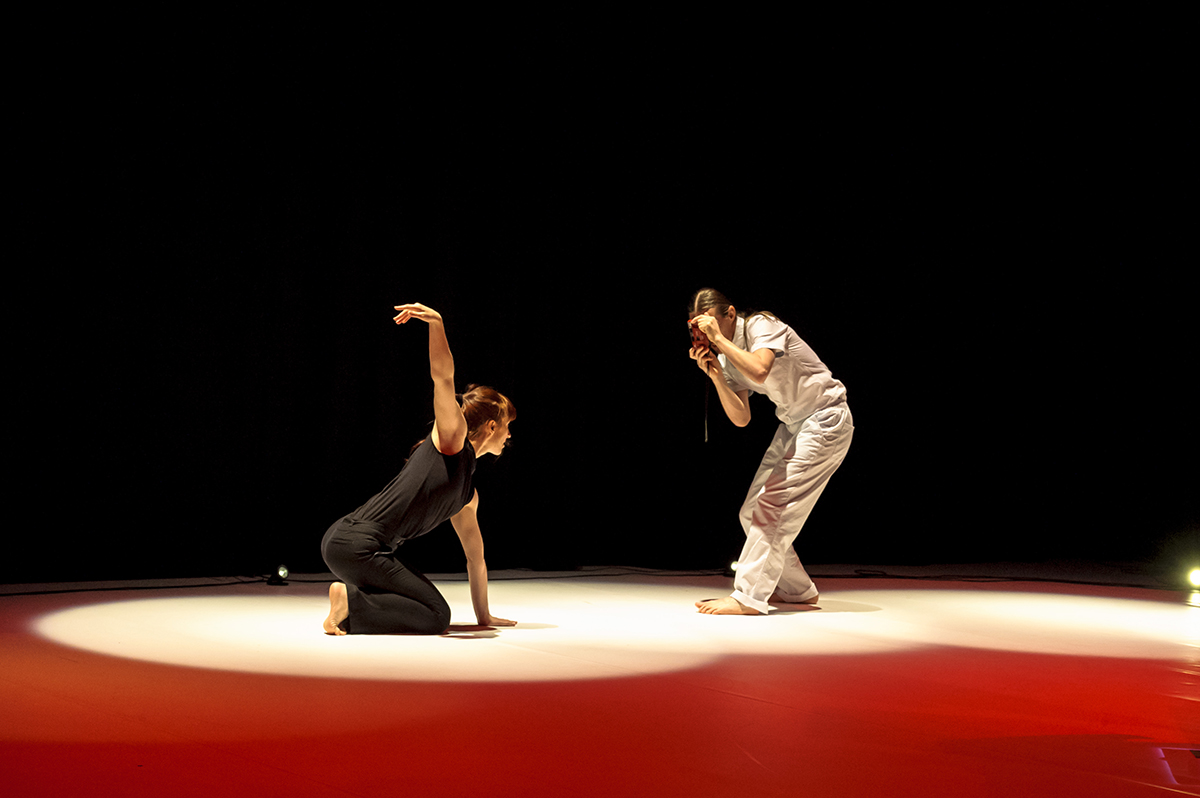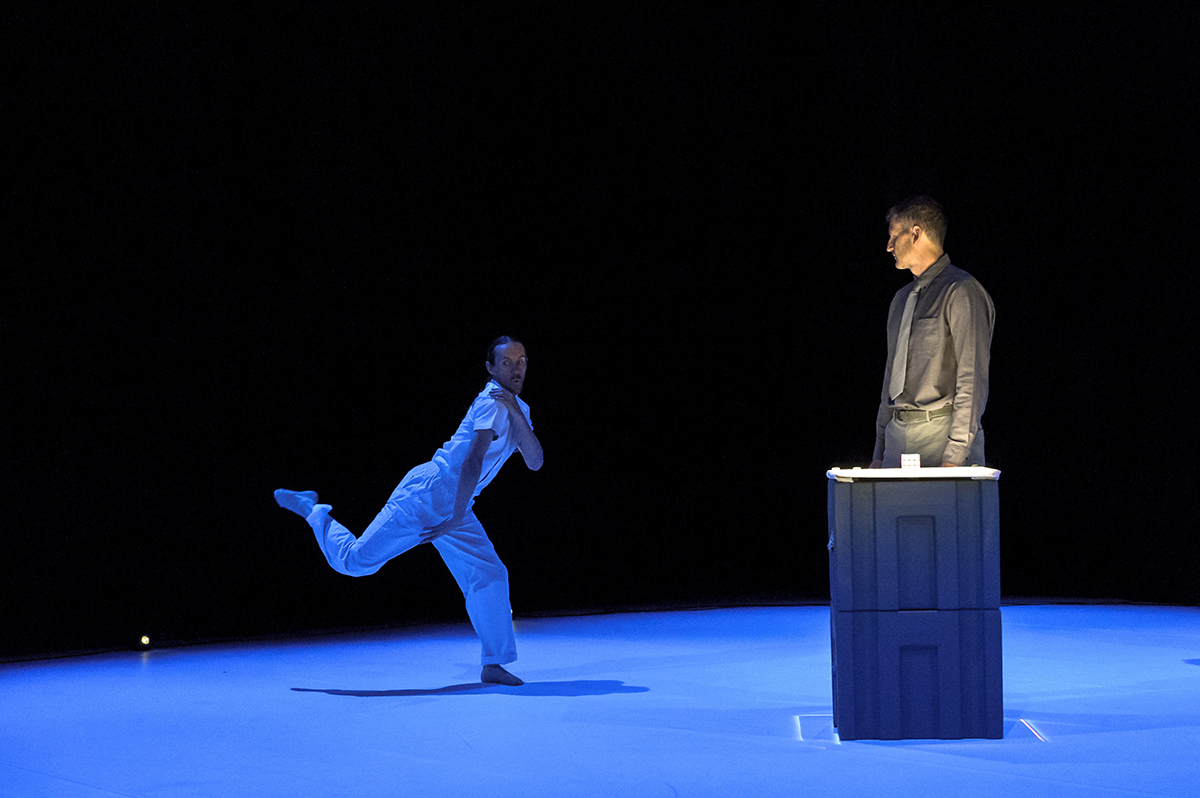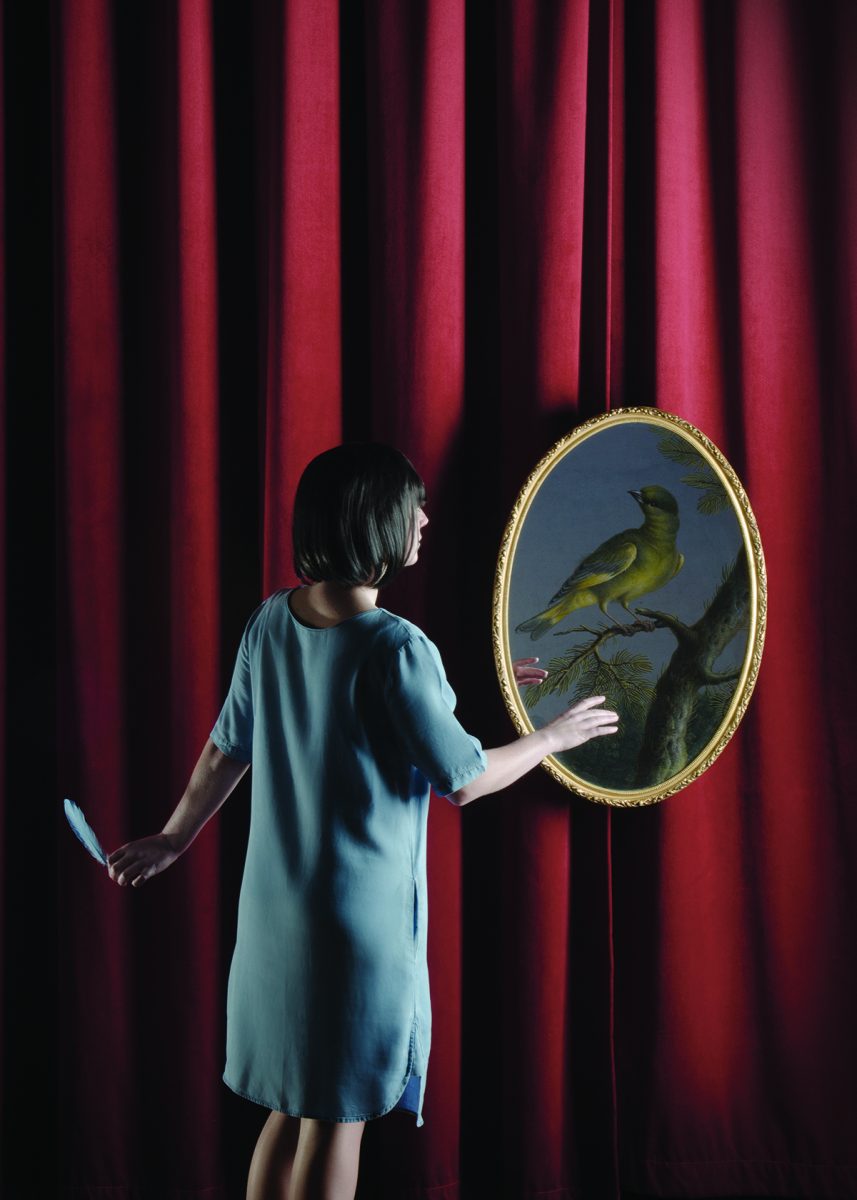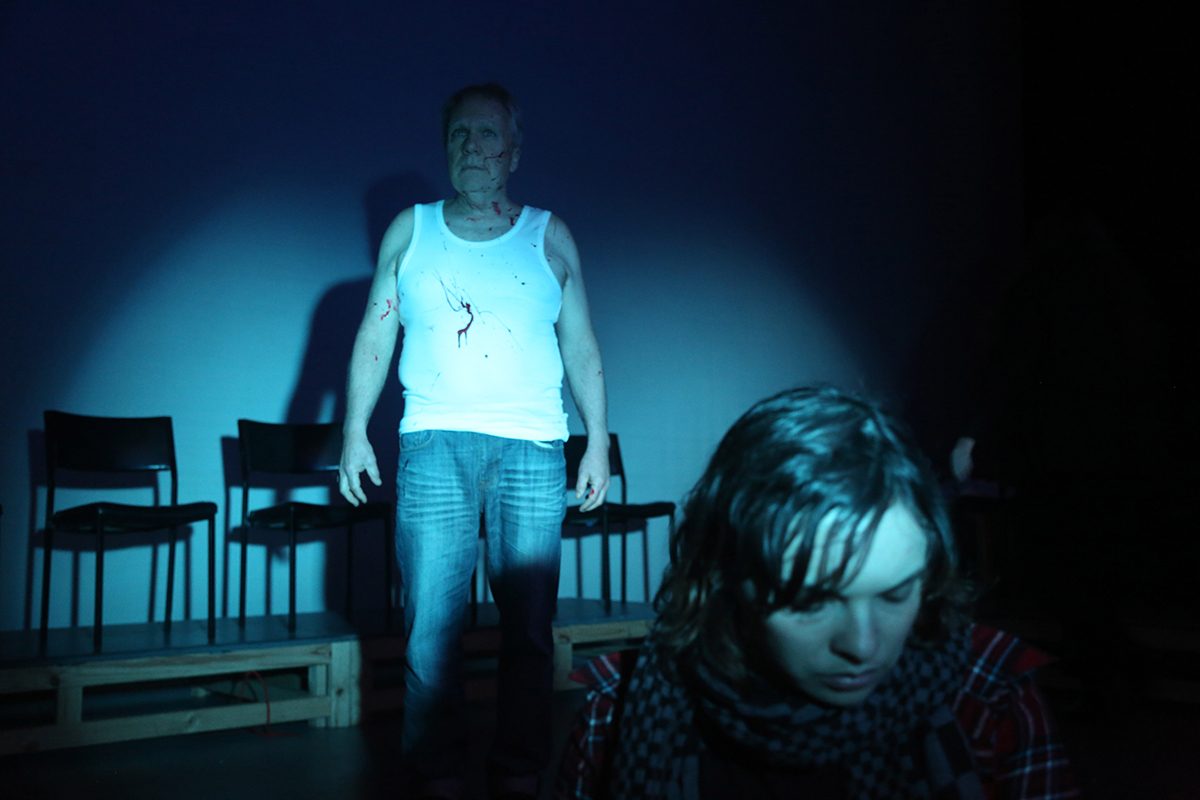Drawing heavily on pop culture and science, Gabrielle Nankivell’s Split Second Heroes conceives of the visible colour spectrum as a science-fictional site of personal struggle and self-discovery. Unusually for a work of contemporary dance — even one that leans towards Pina Bausch-like dance-theatre, if without its multivalent meanings — the bodies on stage represent emotionally distinct characters.
There is Black (Nankivell), a risk-taking sort with a penchant for danger and things that go fast (racehorses, sports cars). There is White (Luke Smiles, also composer and sound designer), an astronautical engineer, locatable perhaps on the autism spectrum by way of his awkward sociality and repetitive behaviour. And there is Grey (Vincent Crowley), achromatic narrator and intermediary, who relates, in the familiar but detached manner of a TED-talk speaker, the unlikely love affair that blooms between his seemingly antithetical counterparts.
We meet Grey first, as monochromatic as Benjamin Cisterne’s set in pallid, jacketless corporate wear and sneakers. Encircled by floor lights, he strides to a sort of rostrum-cum-control panel — two vertically-stacked industrial packing crates — from where he is able to stop and start the dancers, and even, with both a prismatic cube and joystick-like device, manipulate their movements and placement in the space.

Split Second Heroes, photo Chris Herzfeld Camlight Productions
Black and White, their distance at first conveyed in highly individualised and expressive solos, gradually converge, Grey describing their depolarisation in terms both whimsical and (pseudo-)philosophical. Each milestone in the relationship — tracing a path of Black’s emotional softening and White’s flight from routine — is marked by Grey’s producing of a representative toy or Lego sculpture (or, in one case, a functional Polaroid camera).
There is a sense at first that the trio, even the ostensibly neutral Grey, are in competition (for dominance of the spectrum?), for example running laps of the space following a rocket launch-style countdown. Black’s athletic, combative choreography is a blur of martial arts-style kicks, blocks and strikes. White’s movements are jerky and robotic, defensive rather than belligerent. Gradually, though, various accommodations are reached, Grey ultimately withdrawing to a place of objectivity, Black and White becoming partners rather than rivals in the intergalactic adventure first signalled by the work’s opening countdown. “I will miss Black and White,” says Grey, as though speaking — not entirely lamentingly — for a broader loss of the old, inflexible certainties.
As in previous collaborations between Nankivell and Smiles, most notably School Dance (2012), Split Second Heroes is rich in Gen X nostalgia. Smiles’ score, making effective use of multiple stereo channels, recalls early video game music, while the pre-digital moment is also evoked by the centrality of the Polaroid camera and Grey’s props (Lego, the arcade-style joystick, even the cube with its Rubik-like colouration). It was, substantially, the 80s too that gave us the figure, captured by Smiles’ White, of the nerd as (anti-)hero.

Split Second Heroes, photo Chris Herzfeld Camlight Productions
It’s a pity then that Nankivell’s text — rather flatly delivered by Crowley — proves frustrating. Though seamed with a non-scientist’s enthusiasm for the workings of the physical world, it too often comes off as trite rather than profound (I kept thinking of what the philosopher Daniel Dennett has dubbed “deepities” — statements that, on one level, are true but trivial and, on another, sound important but are essentially meaningless).
Grey’s control panel is similarly misconceived, too small and fiddly to register fully in each moment, and strangely causally inconsistent — sometimes the pressing of a button or moving of the joystick seems to do something, for example, trigger a piece of music or choreographic shift, and sometimes there’s no obvious effect.
More successful is Will O’Mahony’s dramaturgy, which effectively centres the work’s constituent parts and provides a stronger narrative through-line than seen in much contemporary dance with its discontinuous performance ideas. Perhaps this in itself is a kind of nostalgia, a return — both pleasurable and faintly unsatisfying — to the privileging of story over idea and image.
–
Gabrielle Nankivell, Adelaide Festival Centre & inSPACE, Split Second Heroes, concept, direction, text, choreography Gabrielle Nankivell, performers Vincent Crowley, Gabrielle Nankivell, Luke Smiles, score, sound design, interactive software design Luke Smiles/motion laboratories, dramaturgy Will O’Mahony, set, lighting design Benjamin Cisterne; Space Theatre, Adelaide, 27-29 July.
Top image credit: Split Second Heroes, photo Chris Herzfeld Camlight Productions
With proportionally fewer subsidised small-to-medium arts organisations than the eastern states, South Australia has not traditionally presented its independent performance makers with a strong or steady supply of opportunities for the development and presentation of new work. Too often the work that does get up feels unready; more often still it does not get up at all, stymied by a lack of funds or the industry partnerships vital to bringing work to stage. With no large injection of money, à la the Victorian Government’s recent $115 million arts funding boost, the driving of the state’s crucial development infrastructure has been substantially left to two modestly resourced but impressively enterprising arts organisations.
South Australia’s nurturers
Vitalstatistix, based in the suburb of Port Adelaide, offers a yearly program of residencies, developments and showings with a focus on multidisciplinary work, culminating in their annual hothouse Adhocracy. There’s also the Performance & Art Development Agency (PADA), founded in 2015 by Vitalstatistix Director Emma Webb and creative producer Steve Mayhew — a key player in the reinvigoration of Country Arts SA’s Performance Development Program (formerly the Local Stages Initiative) — to develop and present new interdisciplinary work.
The other major player is the Adelaide Festival Centre’s inSPACE program, established in 2002 to provide South Australia-based artists access to the Centre’s framework of administrative, venue and production support. This will be the first of two articles assaying the range of development opportunities available to both emerging and established South Australian artists and will focus on inSPACE.
A second article will explore Vitalstatistix’s developmental programs and the new opportunities afforded by PADA. In a blog post last year, Steve Mayhew lamented South Australia’s current unconfident, insular style of cultural leadership, contrasting it with Victoria’s: “They relate locally with a national and international perspective,” he wrote, “they have that global/local view, the ability to encourage and gently persuade with vision.” As both an observer and beneficiary of development programs in Adelaide I believe the cultural shift necessary to foment this vision is, incremental though it may be, already underway from the grassroots up.
inSPACE
inSPACE is a flexible program, responsive to the often widely divergent needs of both emerging and mid-career artists usually engaged in innovative, cross-artform practice. Each year, five to eight artists or groups are selected to develop a work over one to four weeks, during which time they are provided with a rehearsal space and sometimes supported through funds for equipment hire and artist wages. A number of additional projects are assisted to full production, either at the Festival Centre’s Space Theatre or a more suitable outside venue.
2017 inSPACE artists
This year inSPACE is supporting the development of eight works across a range of genres including theatre, dance and music. Each will have two public showings at the end of the development process. Three projects, meanwhile, will have full presentations: choreographer Gabrielle Nankivell’s Split Second Heroes, developed through inSPACE in 2015 and 2016; playwright Emily Steel’s confessional solo show Rabbits, the fruit of a 2012 inSPACE Fringe Development Award and presented this year as part of State Theatre Company of South Australia’s State Umbrella program; and, following an inSPACE development last year, Angelique, by all-female independent theatre collective isthisyours?
Art vs attenuation
Adelaide Festival Centre Programming Executive Ben Hambour has overseen 42 inSPACE developments and 13 full productions since taking on the role in 2013. When I ask him about the conversion rate from development to presentation in that time, Hambour paints a picture of attenuation in the wake of the infamous 2014 “Brandis heist” that saw $104.7 million ripped from the budget of the Australia Council. “We did have Australia Council funding for four years of this program,” Hambour says, “which gave us a lot more money to give to artists and freed up our resources to put into other areas of the program. We lost that after the shift to Brandis’ National Program for Excellence in the Arts and then Catalyst. We were unsuccessful in our application for Catalyst funding, so we’re doing it with fewer resources than we had three or four years ago. Our goal is to have three to four presentations a year and around six to eight developments, so on those numbers about 25% hopefully come through and present with us or somewhere else. We just want them to have a presentation outcome.”
Come September, inSPACE will be reapplying for funding through the Australia Council. In the meantime, Hambour and his team have had to make do with less, supporting around half the number of developments they were previously able to while (successfully) approaching the Adelaide Festival Centre for a larger share of their funding pool. A couple of years ago the program lost both its funding and space, a period which saw artists rehearsing in churches and warehouses — anywhere they could find. Things have at least improved since then.
In fact, as Hambour tells me, in some ways these challenges led to an invigorating phase of creativity and industry solidarity: “When we lost our space and funding things weren’t looking good for the program so I reached out to various people and organisations, one of which was the State Theatre Company who came on board to help us develop Rabbits.” Hambour also secured a long-term venue for the program — the old Ausdance studios in Station Arcade, which will most likely remain inSPACE’s home until the conclusion of the major Adelaide Festival Centre and riverbank redevelopment currently underway — and is applying for funding to partner with local management and producing duo Jones MacQueen to provide business support and mentoring for artists.
Opportunities for the development of new work seem often to be skewed towards young and emerging artists, a reflection of the arts industry’s preoccupation with the “next big thing” and, perhaps, an oblique acknowledgment of the sector’s high levels of dropout and burnout. Hambour tells me the average length of developments has in the last couple of years fallen from three to two weeks, partly because of the increasing number of artists engaged in full-time work outside of their creative practices.
Looking at this year’s program, however, it’s far from obvious that inSPACE prioritises emerging over established artists. Says Hambour: “We’ve discussed this a number of times over the years, whether or not we put a line in the sand and say this is only for emerging artists, in the first however many years of their practice and so on but it’s difficult to effectively have those cut-off points. There are a lot of grey areas. Having said that, we do generally lean towards emerging artists while at the same time looking at the strength of each application. We also consider, usually at the start of the process, opportunities for collaboration with other festivals at the Adelaide Festival Centre — DreamBIG Children’s Festival, OzAsia and the Adelaide Cabaret Festival for example — and ask if there’s a potential presentation opportunity there for any of the works at the appropriate time.”
Hilary Kleinig, The Lost Art of Listening
Two artists currently developing works with inSPACE who describe themselves as established or mid-career are Hilary Kleinig and Jamie Harding. Kleinig, composer, cellist and one quarter of adventurous string ensemble Zephyr Quartet, is developing The Lost Art of Listening, which she describes as “a research, development and composition project investigating how we give and receive music and what it means to listen in an age of 24-hour connectedness.” The inSPACE development, following a showing in last year’s Adhocracy, will result in a piece for prepared piano and audience-played smartphone choir. Writing to me by email from Amsterdam, Kleinig observes: “It is very apparent that there are not the same opportunities and venues for artists of all levels in Australia as there are here in Europe. If we don’t have programs like inSPACE how will the next generation of leaders learn their craft, have space to make mistakes and feel part of a society that validates them for their choice of career?”
Gener8 Theatre, Cold As Ice
Mount Gambier-based Gener8 Theatre’s Cold As Ice — a grassroots-focused exploration of the effects of crystal meth use in small communities, using Google Cardboard virtual reality technology — represents inSPACE’s first relationship with a regional theatre company. Artistic Director Jamie Harding, who is co-writing, directing and performing in the work, describes the development as a major step forward for the company. “With our work,” Harding tells me, “we aim to diversify from where we’ve been and continually turn the gaze towards new ideas, new models while also making stories that connect universally. As a company we are focussed on the challenge of getting greater diversity into regional and metropolitan theatre and also to get our regional stories on stages state- and nationwide. It is refreshing to be inside a program that respects artists as well as giving us extra support, whether that be financial assistance or help with admin or mailouts leading up to vital showings, that has allowed us to do what we do best, which is focus on making work.”
Gabrielle Nankivell, Split Second Heroes
Having come through inSPACE’s development stream in 2015 and further developed last year at a research lab supported by Australian Dance Theatre and Adelaide College of the Arts, Gabrielle Nankivell’s Split Second Heroes is being fully produced for the first time this year. How critical, I asked Nankivell by email, had the inSPACE development been to the evolution of Split Second Heroes?
“The program has specifically benefited the technical development of my work,” she told me. “It is one of the only residency situations in SA with the resources to support dedicated, potentially in-theatre, technical development as part of creative process. The program creates a platform for the artist and producer (inSPACE) to develop an in-depth understanding around the rigour of a project and the artistic/technical/market requirements for continued development/presentation. Having access to a fully-equipped space (Marion Cultural Centre and the Space Theatre) and gear across two developments in 2015-16 has significantly contributed to Split Second Heroes making it to the stage as a fully-fledged show in 2017.”
Falling thought the cracks
Like Kleinig and Harding, Nankivell falls into the category of what Ben Hambour calls the artists who “fall through the cracks” — that is, those who are neither emerging (usually defined as within the first five years of professional practice) nor sufficiently established to have the weight of a subsidised company behind them. “I’ve been referred to as both ’emerging’ and ‘established’,” Nankivell says, “often within the same time-frame. I think there is an abundance of opportunities for support in the ‘emerging’ category. So what happens to these artists once they have ‘emerged’? Closer consideration needs to be given to the mid-career phase — that long span of time in an artist’s career where potential and ideas become experience and vision. Supporting this somewhat lost zone is important for developing a strong and diverse ecosystem in the arts and ensuring Australian artists have opportunities to pursue sustainable career trajectories.”
Whatever the challenges of the current funding environment, inSPACE seems well placed to continue providing South Australian theatre-makers with such opportunities. Like the artists it supports, it is defined by its resilience and adaptability—not buzzwords in this context, but strategies for survival.
–
inSPACE: Gabrielle Nankivell, Split Second Heroes, concept, direction, text and choreography Gabrielle Nankivell, score, sound design and interactive software Luke Smiles/motion laboratories, Space Theatre, 27-29 July; State Theatre Company, Rabbits, writer, performer Emily Steel, direction Daisy Brown, design Wendy Todd, Plant 1, Bowden, 21 Sept-14 Oct; isthisyours?, Angelique, direction Tessa Leong, writer Duncan Graham, performers Jude Henshall, Louisa Mignone, Nadia Rossi, Ellen Steele, Her Majesty’s Theatre, 13-22 Oct
Top image credit: Split Second Heroes, Gabrielle Nankivell, inSPACE, photo Chris Herzfeld — Camlight Productions
Two dance theatre works at this year’s OzAsia Festival attested to the form’s remarkable elasticity and varied, if not always lucid, methods of making meaning from the everyday.
The Record
Properly speaking, the first, 600 Highwaymen’s The Record, ought not to have been in the festival at all. Its creator-directors are Americans Abigail Browde and Michael Silverstone, and the work doesn’t otherwise explicitly engage with Asian culture or themes.
I was, nevertheless, grateful that OzAsia Artistic Director Joseph Mitchell’s enthusiasm for The Record overrode any parochialism that might otherwise have kept it out. It’s a deeply humane and affecting work, one that subtly bonds its non-professional performers and audience as it seeks to codify the complex rituals of human interactions between strangers by means of a stripped back, gestural aesthetic. In the process, our position as viewers is inverted as the performers—dressed much as we are in ordinary chinos, shirts, trainers and the like—stare expressionlessly out at us.
In The Empty Space, Peter Brook famously noted that all that is needed for an act of theatre to take place is for someone to walk across an empty space while being watched by another. So begins The Record. A single performer—in this case, a schoolgirl in uniform—walks to the centre of Chris Morris and Eric Southern’s austere set: a rectangular strip of unvarnished wood overhung with a long, white piece of cloth behind which a soft light rises and falls in intensity throughout the work’s 60 minutes. After what seems an interminable stretch of stillness and quiet, the girl strikes a series of classical poses—for example, back leg dipped, front leg powerfully jutting, one fist raised in the air—of a kind that will be repeated and extended by the rest of the performers.
The poses have the effect of heroicising the everyday, just as the work more broadly foregrounds the ordinary, throwing its performative aspects into sharp relief. As the poses are struck before dissolving into tableaux, cellist Emil Abramyan, placed to one side of the wingless stage, picks out pizzicato chords, later performing elements of Italian composer Carlo Alfredo Piatti’s Caprice No 2, his bow playing introducing a warming melodiousness. Brandon Wolcott’s electronic score, played live via a laptop and combining drones, crackles and machine- and speech-like disturbances, provides additional layers of ambient sound.
The performers who join the schoolgirl—gradually at first, singly and in pairs, then in long, dizzying files towards the finale—comprise a stunningly diverse group (perhaps this alone is justification enough for The Record’s inclusion in a cross-cultural arts festival) made up of 45 people selected from the community. Together, they form a sort of living document of the vastly differing ages, nationalities and body types represented here, at this time. There’s an Adelaide Airport worker in hi-vis shirt and dark pants; a young, heavily pierced woman in pale makeup and gothic dress; a slim Chinese-Australian in her 20s; and children of both sexes in casualwear or long, animal-patterned pyjamas. We often hear, and it’s true, that our stages fail to reflect the ethnic and cultural diversity with which our city streets teem; The Record spectacularly corrects this imbalance, and in a way that feels quietly revelatory.
The performers, each of whom rehearsed individually and had not met each other prior to the first performance (the one I attended), frequently watch us in a gently probing exchange that calls attention to our own heterogeneity and status as strangers to one another who are, nevertheless, intimately linked by time and place. Those close-quarters, sometimes long-held gazes, as well as the moments of physical connection between the performers—pugilistic fists compassionately drawn back, hands and falling bodies briefly held, as in a trust exercise—accrue a tremendous emotional force, especially as they counterpoint the increasing mass of bodies and activity on stage. (At various points, multiple performers jog around the perimeter of the space, a reminder perhaps of the frenetic pace of life outside the theatre.)
Eventually, most of the performers disperse, leaving a small group upstage that includes, at the last, the two musicians, a low wash of sound playing out as Wolcott leaves his computer. Finally, just one woman remains. She moves downstage in her plain clothes as far as the seating bank will allow, looking, somehow, less lonely than the schoolgirl had, at peace with herself and the world. I want to hug her, or for her to reach out and touch me. Only this final, longed-for gesture is withheld in a work that is exceptionally and movingly generous.
As If To Nothing
Not to be confused with Craig Armstrong’s 2002 ambient electronic album with the same title, City Contemporary Dance Company’s As If To Nothing proved an altogether more mixed experience. Founded in 1979 by longtime Artistic Director Willy Tsao, the company has toured extensively internationally, its more than 200 productions to date reflecting trends in Chinese contemporary dance as well as, latterly, the vibrancy of post-Handover Hong Kong, where the company is based. As If To Nothing has been around since 2009, and it’s tempting to suggest the production’s age accounts, at least in part, for its slight tiredness (Brook again: “about five years is the most a particular staging can live”).
Sang Jijia’s set is a vertiginous white box. Its floor is faux-marble, polished and smooth. Within it resides both a smaller, narrower box on wheels, like a caravan or food vending truck but reminiscent of a scaled-down modern apartment in its sharp, white minimalism, and a section of wall into which, at one end, a full-size table on casters has been embedded. Cut into the box and wall segment are doorways and glassless windows through which the 14 performers—both male and female, each physically powerful and drably attired in loose, grey slacks, dresses and t-shirts—variously protrude faces and limbs.
The choreography, again by Jijia, lightly reflects the influence of mentor William Forsythe (Jijia spent four years with Forsythe’s Dresden-based company, returning to China in 2006) in its—not always cohesive¬—melding of the abstract and representational and its incorporation of technology and the spoken word. As If To Nothing’s structure further recalls Forsythe’s work in that it’s broken into eight segments—delineated, sometimes untidily, by blackouts—which both repeat and subtly evolve the obsessively enacted, tic-like gestures of each previous vignette.
The constantly shifting set and relentless kineticism of the dancers, all framed by the projection onto the walls and box of Adrian Yeung’s live video capture—sometimes delayed to disorientating effect, often freakishly distorted or punctured by gaps—is intended to invoke the slippery unreliability of memory. But it was, for me, the work itself that remained fundamentally muddled. Without subtitles, little sense can be made of the dancers’ exhortations, and I was left puzzled by the frequent manipulation of a small section of the box, repeatedly slid out and back like a desk drawer.
For all its technological saturation, too, some of the vignettes, such as a duet between a male and female dancer, feel oddly conventional, even trite. The video projections, though competently handled by Yeung, are unimpressive in themselves and further suffer from the work’s dysfunctional logic, which reduces them to empty spectacle. Only Dickson Dee’s insistently percussive live score, featuring industrial noise, arpeggiated piano and nightmarishly altered everyday sounds like clock ticks and alarms, was able to sustain my curiosity.
–
2016 OzAsia Festival: 600 Highwaymen, The Record, creators, directors Abigail Browde, Michael Silverstone, music Emil Abramyan, Brandon Wolcott; Space Theatre, 21-24 Sept; City Contemporary Dance Company, As If To Nothing, set design, choreography Sang Jijia, video design Adrian Yeung, music Dickson Dee; Dunstan Playhouse, Adelaide Festival Centre, 22-24 Sept
Top image credit: The Record: Adelaide, 600 Highwaymen, OzAsia 2016, photo Claudio Raschella





